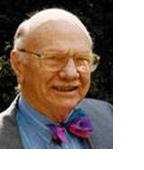|
|
Dr Harry Morrow Brown – in his own words |
|
A year earlier he had sent us the text of a CV, subtitled 'my pre-obituary', that he had drawn up for a conference at which one of his posters was being presented. We promised to save it and use it when the time came. It now has. For a far fuller understanding of his work, check in to his extensive website, www.allergiesexplained.com; for a more personal tribute check in to the FoodsMatter blog. Dr Harry Morrow Brown was born in Auchterarder, Scotland in 1917, qualified MB ChB Edinburgh University in 1939, and served in Royal Army Medical Corps from 1939 to 1946, mainly in India. Post-Graduate studies in Edinburgh led to an interest in low sodium rice diet for hypertension, finally resulting in a Thesis on "Adaptation and Adaptive Dysfunction" which was accepted with commendation for MD in 1950. The main conclusion was that allergies are the most common manifestation of faulty adaptation to the environment, but there was no possibility to develop this concept in 1950. He became a member of the Royal College of Physicians of Edinburgh in 1949, and was elected a Fellow in 1965. He received an Honorary Doctorate from Derby University in 2004, and was elected an International fellow of the American Academy of Allergy in 2006. Oral steroids and asthma These striking findings were published in the Lancet in 1958 (Lancet 1958:ii:1245) but attracted no attention whatsoever, even though this was actually the very first study to show that the presence of eosinophils indicates steroid responsiveness. It was many years before sophisticated methods of examining induced sputum confirmed his findings. Clinical allergy research The ability to select steroid responsive patients proved very helpful for clinical management, but Morrow Brown was not satisfied with long-term oral steroids because of side-effects and became deeply involved in clinical allergy.The result was that from 1958 onwards he built up an allergy research centre, supported by a local charity he founded, and by organising five "Charles Blackley International Symposia on Clinical Aspects of Allergic Disease" at Nottingham University between 1973 and 1984. Steroid aerosols The results were dramatic and BDP aerosols were reprieved from the dustbin within a few months. The results were announced for the first time at the European Congress of Allergology in October 1971, and published in the British Medical Journal in 1972 (BMJ 1972; i :585) soon followed by many confirmatory studies. The first study of BDP in children was published in the following year (BMJ 1973;3;161-i64) and finally a long term survey of children in 1980. (Practitioner 1980: 224: 847-51) Several years ago he produced a very large website (www.allergiesexplained.com) containing an account of his researches and clinical experience with allergy since 1958 for anyone interested, and so that the public can access this information. Good fortune and serendipidy have played an important part in his career, backed by a passion for microscopy and personal investigation. He has developed methods of using the patients's own housedust for skin testing, and produced several portable air sampling devices in his well-equipped workshop for investigating occupational and environmental asthma. He invented a standardised skin testing needle, a re-breathing bronchial provocation test, and a 'microspoon' to hold the right amount of grass pollen for nasal provocation. Dr Harry Morrow Brown – August 2012 More articles on the management and treatment of food allergy and intolerance |

 Dr Harry Morrow Brown died on 22nd August 2013, aged 96.
Dr Harry Morrow Brown died on 22nd August 2013, aged 96. 










